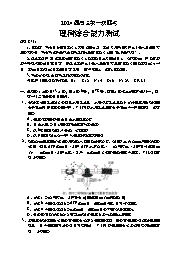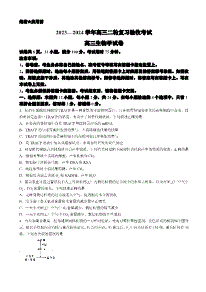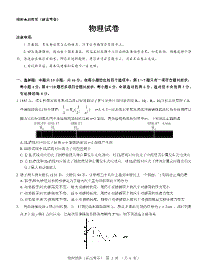2024届高三第一次联考英 语注意事项:1.答题前,考生务必在答题卡上将自己的姓名、座位号和考籍号用0.5毫米黑色签字笔填写清楚,考生考试条形码由监考老师粘贴在答题卡上的“贴条形码区”。2.选择题使用2B铅笔填涂在答题卡上对应题目标号的位置上,如需改动,用橡皮擦擦干净后再填涂其它答案;非选择题用0.5毫米黑色签字笔在答题卡的对应区域内作答,超出答题区域答题的答案无效;在草稿纸上、试卷上答题无效。3.考试结束后由监考老师将答题卡收回。第一部分 听力(共两节,满分30分)做题时,先将答案标在试卷上。录音内容结束后,你将有两分钟的时间将试卷上的答案转涂到答题卡上。第一节 (共5小题;每小题1.5分,满分7.5分)听下面5段对话,每段对话后有一个小题,从题中所给的A、B、C三个选项中选出最佳选项。听完每段对话后,你都有10秒钟的时间来回答有关小题和阅读下一小题。每段对话仅读一遍。1. How will the woman probably go to the City Library?A. By bike.B. By car.C. By bus.2. What will the speakers do next?A. Take a rest.B. Board the plane.C. Leave for the hotel.3. Why does the man make the phone call?A. To offer an invitation.B. To cancel a cooperation.C. To make an appointment.4. How much did the man pay for the electric kettle?A. 40 dollars.B. 20 dollars.C. 10 dollars.5. Where are probably the speakers?A. In a gym.B. In a clinic.C. In a workshop.第二节 (共15小题;每小题1.5分,满分22.5分)听下面5段对话或独白。每段对话或独白后有几个小题,从题中所给的A、B、C三个选项中选出最佳选项。听每段对话或独白前,你将有时间阅读各个小题,每小题5秒钟;听完后,各小题将给出5秒钟的作答时间。每段对话或独白读两遍。听第6段材料,回答第6和第7两个小题。6. When did the man come back?A. On Monday.B. On Saturday.C. On Sunday.7. What did the man do in Leeds?A. He visited a park.B. He designed a product.C. He made a presentation.听第7段材料,回答第8至第10三个小题。8. Why does the man come to the woman?A. To ask for leave.B. To make an apology.C. To report work progress.9. Who will replace the man?A. Nobody.B. Richard.C. Sally.10. How does the man feel about finishing his work on time?A. Doubtful.B. Hopeless.C. Confident.听第8段材料,回答第11至第13三个小题。11. What is the woman’s concern about the man?A. His idea of honesty.B. His absence from classes.C. His explanation of basics.12. What does the woman suggest the man do?A. Join a history club.B. Memorize some tricks.C. Read up on some books.13. What’s the probable relationship between the speakers?A. Classmates.B. Mother and son.C. Teacher and student.听第9段材料,回答第14至第17四个小题。14. What is the man doing?A. Listening to a talk.B. Hosting a talent show.C. Conducting an interview.15. What does Annie do?A. She is a writer.B. She is a photographer.C. She is a journalist.16. What does Annie value most in her job?A. Curiosity.B. Generosity.C. Courage.17. What does Annie think of her job?A. Well-paid.B. Rewarding.C. Difficult.听第10段独白,回答第18至第20三个小题。18. Where does Yang Rui live?A. In the suburbs.B. In the city center.C. In a remote village.19. What’s Yang Rui’s main purpose of renting a small vegetable garden?A. To reduce work stress.B. To have organic vegetables.C. To involve his kids in farming.20. What is the speaker mainly talking about?A. A popular lifestyle.B. A low carbon farm.C. A monitoring system.第二部分 阅读理解(共两节,满分40分)第一节 (共15小题;每小题2分,满分30分)阅读下列短文,从每题所给的A、B、C和D四个选项中,选出最佳选项。AAll across the country, you’ll find film locations that may still scare you years after the release of some of the most iconic horror movies of all time. When you’re ready for a truly horrifying road trip, here’s where to go.Hocus PocusHocus Pocus may have more comedic elements than the average supernatural film, but this movie has its share of scares, murders, curses and spells. Of course, the movie is about a group of witches. The movie takes place in Salem, Massachusetts. One location, in particular, is Ropes Mansion, a Colonial Revival home that was featured in the trick-or-treating scene.The ShiningWhile The Shining wasn’t actually filmed at The Stanley Hotel in Estes Park, Colorado, this historic hotel that dates to 1909 is said to be Stephen King’s inspiration for the movie’s Overlook Hotel. This alone has been enough to draw a large number of fans to this small mountain town that serves as the primary gateway to Rocky Mountain National Park. The hotel even offers a one-hour guided experience called The Shining Tour. The RingThe 2002 supernatural horror movie The Ring was filmed primarily in Washington, including Seattle and Whidbey Island, but the Yaquina Head Lighthouse in Newport, Oregon, was also a location in the movie. The historic 93-foot-tall lighthouse — the tallest lighthouse in Oregon — served as the mysterious Moesko Island Lighthouse in the film.Rocky Horror Picture ShowAn ideal setting for Dr. Frank-N-Furter’s dealings, this impressive Victorian Gothic country house sits on an area of 35 acres overlooking the River Thames in England. When it isn’t being used as a film set, Oakley Court is a luxury hotel and event center that entertains its fair share of English royalty.21. What can visitors do in The Stanley Hotel?A. Play the trick-or-treating game.B. Have a tour guided by the hotel.C. Get inspiration for horror movies.D. Meet with the fans of the hotel.22. What’s special about Oakley Court?A. It is the most horrifying.B. It has splendid river views.C. It caters to only English customers.D. It will no longer be used as a film set.23. Where can the text be found?A. In a story book.B. In a movie review.C. In a film poster. D. In a travel magazine.BHe had been a Christmas present to my second son. Brian, at six, wanted something that was his alone, something not handed down — as were his clothes and toys — from his older brother. And so, on Christmas Day 1954, I rose early with my wife to put the tiny kitten a neighbor had given us into the stocking that Brian had carefully fastened to the mantelpiece (壁炉台) the night before. From then on, the life of the cat, Tiger, was full of love. For a sometimes fumbling child, Brian showed great gentleness with Tiger, which was amazing. Every night, when I checked on the children, I would invariably find Tiger on Brian’s bed, stretched out beside him. One evening our next-door neighbor rang the front doorbell. “I’m sorry to have to tell you this,” she said when my wife answered the door, “but when I backed out of the driveway this afternoon, I’m afraid I ran over your cat. I tried to help him, but he jumped up and ran away. I don’t know where he went or how badly he was hurt.” Four weeks passed with no sign of Tiger. Brian tried to hide his fear that his friend had crawled away to die. It was a fear we all shared. And we came to accept his death — all of us except Brian. Every evening Brian would go to the door and call Tiger’s name. Finally, on the 28th day after the neighbor’s unwelcome announcement, he had an answer. Out from under the front porch came Tiger, his tail high, walking with the pride, behaving as if he had never been away. As he approached the door, Brian’s face was transformed with joy. But neither he nor Tiger displayed open affection in front of the family. There was a calm acceptance, an honoring by each of the other’s dignity. That night, though, when I checked Brian’s room, I saw that his cheeks were wet and a smile was on his face and his arm encircled his cat, who lay purring quietly beside him.24. Why did the author give Brian the cat as a Christmas gift?A. The author had no better choice.B. The neighbor gave the author a cat.C. Brian expected to have a cat of his own.D. The cat is not “second-handed” from Brian’s brother.25. What does the underlined word “fumbling” in Paragraph 2 mean?A. Tough.B. Unhappy.C. Careful.D. Excited.26. What did the next-door neighbor do to Tiger?A. She abandoned Tiger.B. She drove Tiger away.C. She hit Tiger while driving.D. She stepped on Tiger while running.27. What is Brian like according to the text?A. Rough and tolerant.B. Caring and reserved.C. Stubborn and positive.D. Independent and determined.CConservators and restorers have made continuous innovations in science and technology applications over the past few years in China to show cultural relics in a new light, literally, and help traditional culture shine with a greater vitality. With modern technology and equipment preserving the true colors of cultural heritage, now people can better appreciate history.A 3D-printed copy of a green-faced Terracotta Warrior from the Qin Dynasty (221-206 BC) at the Emperor Qinshihuang’s Mausoleum Site Museum (Xi’an) recently attracted a large and appreciative audience at an exhibition in Chongqing, Southwest China.The exhibition, Crafts First: Technology and Equipment for Cultural Relics Preservation, kicked off on Sept 27 and showcases technologies and equipment used in the prevention of damage, protection, research and management, as well as the use of cultural relics. It is said to be the first of its kind in the country. The exhibition will last three months.The original Terracotta Warrior, on which the copy on show is based, was unearthed from pit No 2 in the Qinshihuang Mausoleum. It is the only one with a green face and is highly valuable for archaeological research, according to deputy curator (馆长) of the museum Zhou Ping.Zhou said that to showcase the green-faced Terracotta Warrior — half-kneeling and painted in green and red — to the public, the museum came up with the idea of promoting a copy by using achievements in archaeology, materials science, arts and crafts, as well as new digitalization technology, such as spectrum analysis, high-definition scanning and 3D printing.“I feel very proud that all the technologies and equipment are domestically developed,” said the curator. “I hope more and more high-tech enterprises are attracted to the field of cultural relics, which we believe is a real blue ocean market.”28. What is true about the 3D-printed copy?A. It was unearthed from pit No 2.B. It is a craftwork of multiple fields.C. It is valuable due to its green face.D. It is a well-preserved cultural relic.29. What do we know about the exhibition?A. It has ended on Sept 27.B. It shows many copies of relics.C. It is a brand new kind of exhibition.D. It attracts a large audience from Xi’an.30. What can we learn from the last paragraph?A. The market related to protection of cultural relics is uncertain.B. China is leading the development of the technologies and equipment.C. More and more high-tech companies are attracted to the field of cultural relics.D. The future of the high-tech companies in the field of cultural relics is promising.31. What is the best title for the text?A. Cherishing Cultural RelicsB. Building Cultural ConfidenceC. Finding a Gap in a New MarketD. Giving Cultural Relics a Fighting ChanceDFor adults, communicating in our first language feels easy and natural. Yet learning language is a complex process that is influenced by several factors. When young children are beginning to learn language, some influences, such as the amount of speech a child hears and the amount of time they spend in back-and-forth language interactions with others, have what may appear to be obvious connections to language learning. Perhaps less obvious is that children’s own physical experiences with their environment help them learn new words.In new research in the cognitive sciences, we investigated how this is the case by considering how children learn words that refer to something they can touch, grasp and interact with. We asked parents to rate how easily a child can physically interact with the object, idea or experiences that a word refers to. We found words that refer to objects that are easy for children to interact with are also words that are learned at an earlier age.For instance, a word such as spoon is usually learned earlier than a word such as sky. And this relationship remains even when we consider other things that can affect word learning, such as how common a word is in everyday language. Words such as spoon and sky are both relevant to everyday life, and so children will probably hear those words quite early in their development. One difference between them is that spoon refers to something they can touch, grasp and interact with, whereas sky does not.Our findings agree with those of studies where babies wore small head-mounted body cameras to record their interactions with objects. Those studies show that the children’s own physical experiences helps them learn new words. For instance, in one study researchers found that 18-month-old babies were more likely to learn the name of a new object when they held that object, and less likely to learn the name if their parent held the new object. Another study found that 15-month-olds who spent more time using new objects had learned more nouns by the time they were 21 months old.32. What is the aim of the new research?A. To see if babies’ physical experiences help them learn new words.B. To investigate how a baby learns names of everyday objects.C. To find out what influences a baby’s language learning.D. To study how a baby interacts with everyday objects.33. Which of the following might a baby learn at an earlier age?A. Bag.B. Heart.C. Milk. D. Leaf. 34. What is the function of the last paragraph?A. To further support their finding.B. To summarize the research result.C. To point out new research directions.D. To introduce results of other findings.35. What can we infer about the author?A. The author is a parent.B. The author is a researcher.C. The author is a professor.D. The author is a journalist.第二节 (共5小题;每小题2分,满分10分)根据短文内容,从短文后的选项中选出能填入空白处的最佳选项。选项中有两项为多余选项。Many owners dream of taking a walk with their dog without a rope and those dreams are not impossible. 36 Tie a collar around the dog’s neck and attach a rope to the collar. Even though your initial goal is to train the dog to walk off-rope, starting his training with a rope keeps him under control. Teach the dog a “watch me” command. It teaches the dog to focus on your face and watch your eyes, which is important to keeping the dog’s attention when you switch to off-rope work. Call the dog’s name and hold a treat close to his nose. 37 The instant the dog looks up and focuses on your face, give him the treat. Ask the dog to “watch me” frequently during the training until he maintains eye contact with each command.Encourage the dog to walk close by your side. Keep a treat in your left hand, holding it just out of his reach. Tell him “Sit down” and step off, taking a few quick steps forward. 38 Slow to a stop, reward him with the treat when he sits, and praise him for remaining in position. 39 You may reach the point where you feel your dog is so obedient that a rope is unnecessary. Nonetheless, have a rope with you at all times when you are training or just out and about with your dog. 40 And be aware of rope laws. No matter how confident you are in your dog’s obedience, those laws still apply.A. Give the order and bring the treat toward your eyes.B. You must tie a rope to the collar around the dog’s neck.C. What you need to do is use a firm on-rope training first.D. If he always focuses on the training, give him plenty of praise.E. Always be ready to tie the rope onto his collar if the need arises. F. Speak in an enthusiastic voice and hold the treat within his reach.G. Repeat the on-rope work with the dog off-rope until he performs perfectly.第三部分 语言知识运用(共两节,满分45分)第一节 (共20小题;每小题1.5分,满分30分)阅读下面短文,从短文后各题所给的A、B、C和D四个选项中,选出可以填入空白处的最佳选项。When my wife and I were young, our budget was tight. We benefited from the 41 of local merchants who understood that treating customers 42 did not mean they were treated the same way.The local fishmonger (鱼贩), who supplied lobster and crab to fish steak houses, showed incredible 43 . We were regulars because our two-year-old had 44 a passion for mussels (贝类). Without 45 , after the mussels were weighed and priced, the scoop (铲斗) went back into the tank — “Just a few extra to 46 for the ones that don’t open.”On one visit, a staff member asked if we had seen the Scottish fish that had come in that morning. “Looks 47 ,” I said. “Just the mussels, thanks.” He 48 if I could make use of some tails: “The restaurant only wants the best fish steaks, and I really don’t have much of a 49 for dealing with these.” Two tails went into the bag, no 50 . “Mussels for the little guy and a 51 for you and your wife.”When my wife was 52 our second child, she developed a strong desire for a local Chinese restaurant’s version of tai dop voy, a mixture of meats, shrimp and vegetables. Even though the owner rarely saw us, he always 53 us. One evening, well into my wife’s eighth month, I ordered tai dop voy to go. When I 54 the bill and left, the bag was 55 than normal. “We are closing soon,” the owner said. “There is some fried rice in there that would be 56 . Enjoy. Have a healthy 57 .” When I got home, there was not only fried rice but also an order of chow mein (炒面) and two orders of tai dop voy.That was many years ago. But those small kindnesses from people who ran 58 businesses made a difference. It wasn’t just the savings — though they were 59 . Customers were seen as more than a source of revenue; we were 60 of the community that the business served.41. A. wisdomB. selflessnessC. honestyD. kindness42. A. carefullyB. strictlyC. equallyD. indifferently43. A. strengthB. patienceC. gratitudeD. thoughtfulness44. A. admiredB. praisedC. discouragedD. developed45. A. failB. enthusiasmC. hopeD. difficulty46. A. make upB. cover upC. look upD. stand up47. A. inexpensiveB. beautifulC. familiarD. pitiful48. A. wonderedB. doubtedC. believedD. worried49. A. appetiteB. planC. giftD. space50. A. chargeB. problemC. doubtD. excuse51. A. treatB. privilegeC. favorD. donation52. A. raisingB. expectingC. holdingD. educating53. A. remindedB. trustedC. rememberedD. missed54. A. settledB. receivedC. skimmedD. split55. A. wetterB. biggerC. heavierD. dirtier56. A. servedB. preservedC. refriedD. thrown57. A. lifeB. babyC. wifeD. diet58. A. localB. familyC. chainD. grocery59. A. acceptedB. appreciatedC. encouragedD. squeezed60. A. inhabitantsB. membersC. customersD. hosts第二节 (共10小题;每小题1.5分,满分15分)阅读下面短文,在空白处填入1个适当的单词或括号内单词的正确形式。The Mona Lisa’s smile is the best example of a lifetime 61 (spend) studying art, science, optics, and every other possible field that he could apply his curiosity 62 , including understanding the universe and how we fit into it.Leonardo spent many pages in his notebook dissecting (解剖) 63 human face to figure out every muscle and nerve that touched the lips. On one of those pages you see a faint sketch at the top of the 64 (begin) of the smile of the Mona Lisa. Leonardo kept that painting from 1503, when he started it, to his deathbed in 1519, 65 (try) to get every aspect exactly right in layer after layer. During that period, he dissected the human eye on dead bodies and was able to understand that the center of the retina (视网膜) 66 (see) detail, but the edges see shadows and shapes better. If you look 67 (direct) at the Mona Lisa’s smile, the corners of the lips turn downward slightly, 68 shadows and light make it seem like it’s turning upwards. As you move your eyes across her face, the smile flickers on and off.Being curiosity about everything just for 69 (curiosity) sake, not simply because it’s useful, is the 70 (decision) trait of Leonardo.第四部分 写作(共两节,满分35分)第一节 短文改错(共10小题;每小题1分,满分10分)假定英语课上老师要求同桌之间交换修改作文,请你修改你同桌写的以下作文。文中共有10处语言错误,每句中最多有两处。每处错误仅涉及一个单词的增加、删除或修改。增加:在缺词处加一个漏字符号(),并在其下面写出该加的词。删除:把多余的词用斜线(\)划掉。修改:在错的词下划一横线,并在该词下面写出修改后的词。注意:1.每处错误及其修改均仅限一词;2.只允许修改10处,多者(从第11处起)不计分。I remember my school days being cheerful and fun while learning many lessons about life. Even though I was able to acquire knowledge from textbooks, the lesson of friendship, teamwork, hard work and discipline I learnt outside the classroom remained closely to my heart. My school days would not be completed without my friends in school. Each year, I got new friends and teachers with who I shared my dreams, doubts or worries. Along with play silly jokes on others, we used to go to the school canteen and got what we liked to eat. We also shared our lunch boxes and complimented the food that made by our mothers. My school days were filled such happy memories, and I am grateful to my school for shaping us as a good student.第二节 书面表达(满分25分)你校将以“我们的劳动实践课(Our labor practice course)”为主题,举办英语征文比赛。请你写一篇英语短文投稿,内容包括:1.学校开展劳动实践课程的目的;2.你遇到的挑战和从中受到的启发。要求:1.词数100左右;2.可以适当增加细节,以使行文连贯。
四川省成都市蓉城名校联盟2023-2024学年高三上学期第一次联考英语试题
你可能还喜欢
购买VIP会员享超值特权
VIP专享免费下载,付费文档最高省50%
免费下载
付费折扣
身份标识
文档工具
限时7.4元/月购买VIP
相关推荐
四川省成都市蓉城名校联盟2023-2024学年高三上学期第一次联考语文答案
2023-11-27 14:10
 5页
5页四川省成都市蓉城名校联盟2023-2024学年高三上学期第一次联考语文试题
2023-11-27 14:10
 10页
10页四川省成都市蓉城名校联盟2023-2024学年高三上学期第一次联考政治参考答案及评分标准
2023-11-27 14:10
 3页
3页四川省成都市蓉城名校联盟2023-2024学年高三上学期第一次联考政治多维细目表
2023-11-27 14:10
 1页
1页四川省成都市蓉城名校联盟2023-2024学年高三上学期第一次联考文科综合能力测试试题
2023-11-27 14:10
 13页
13页四川省成都市蓉城名校联盟2023-2024学年高三上学期第一次联考理科综合能力测试试题
2023-11-27 14:10
 17页
17页四川省成都市蓉城名校联盟2023-2024学年高三上学期第一次联考
2023-11-27 14:10
0页
江西省宜春市丰城中学2023-2024学年高三上学期期中考试 英语
2023-11-27 14:54
 14页
14页










